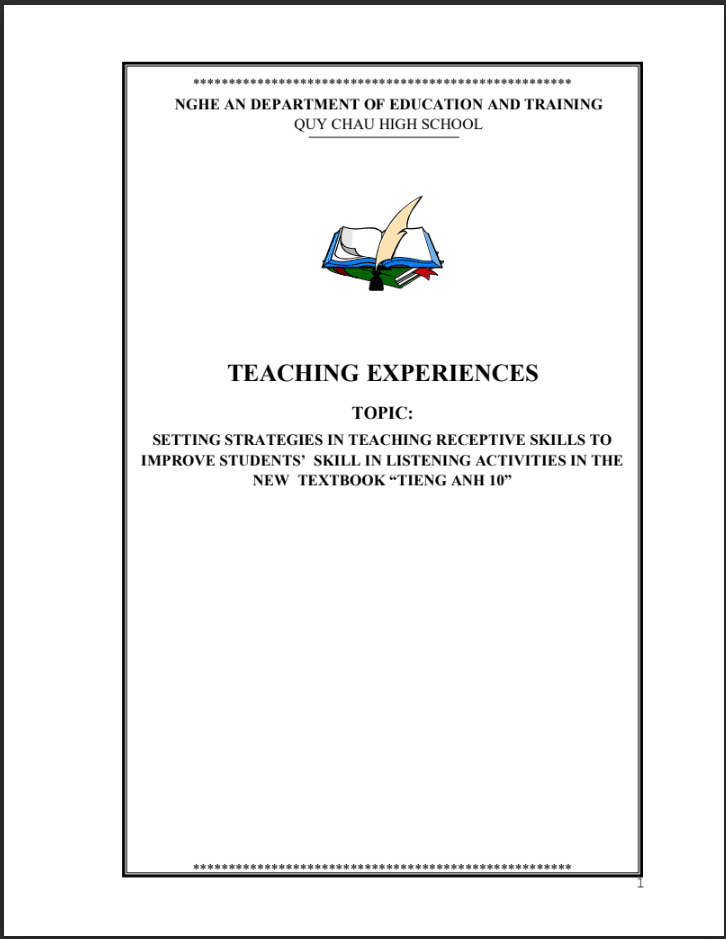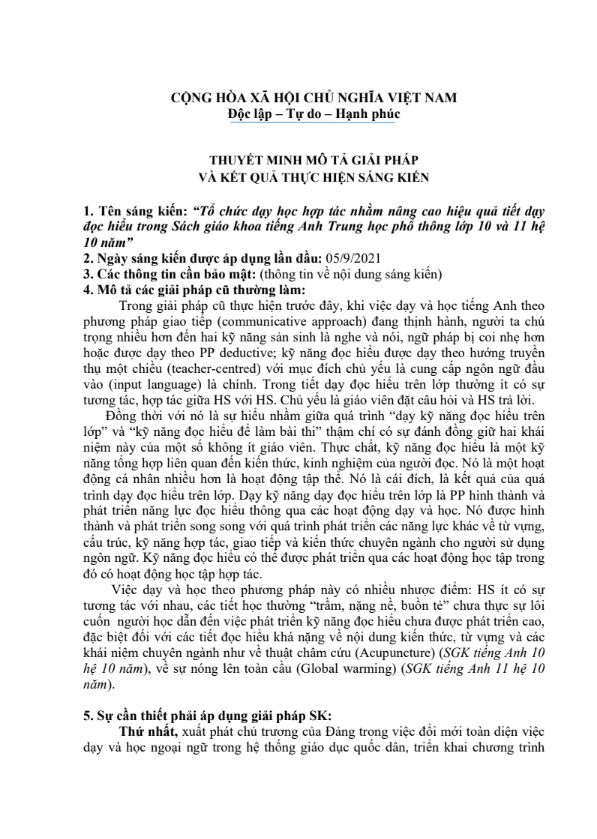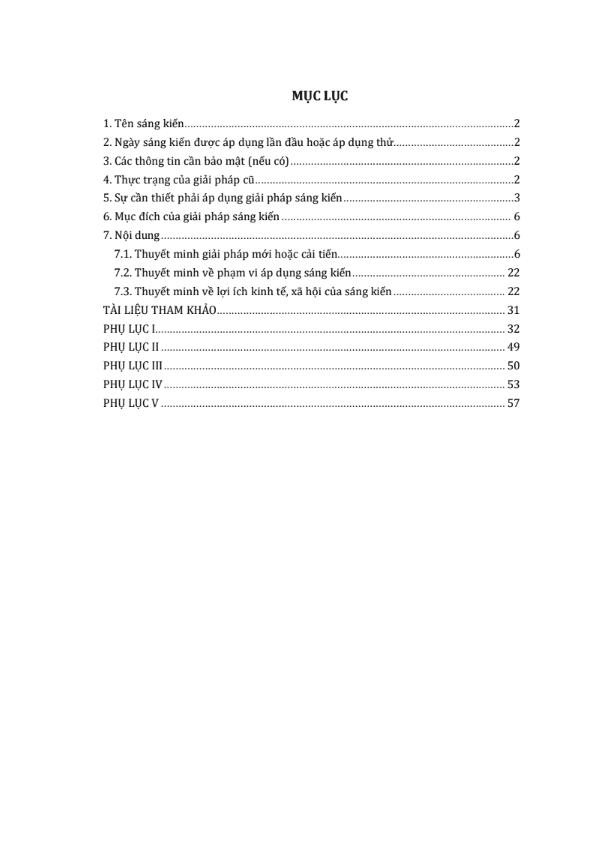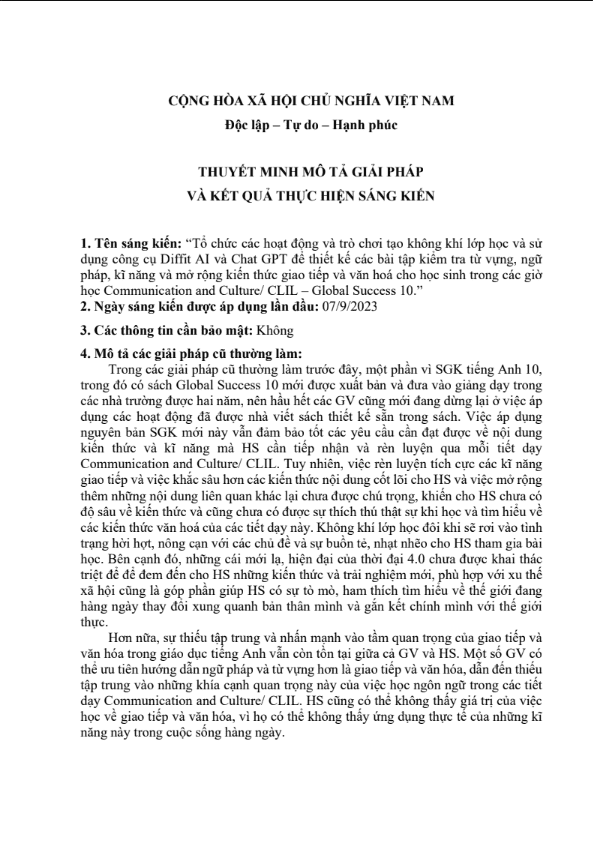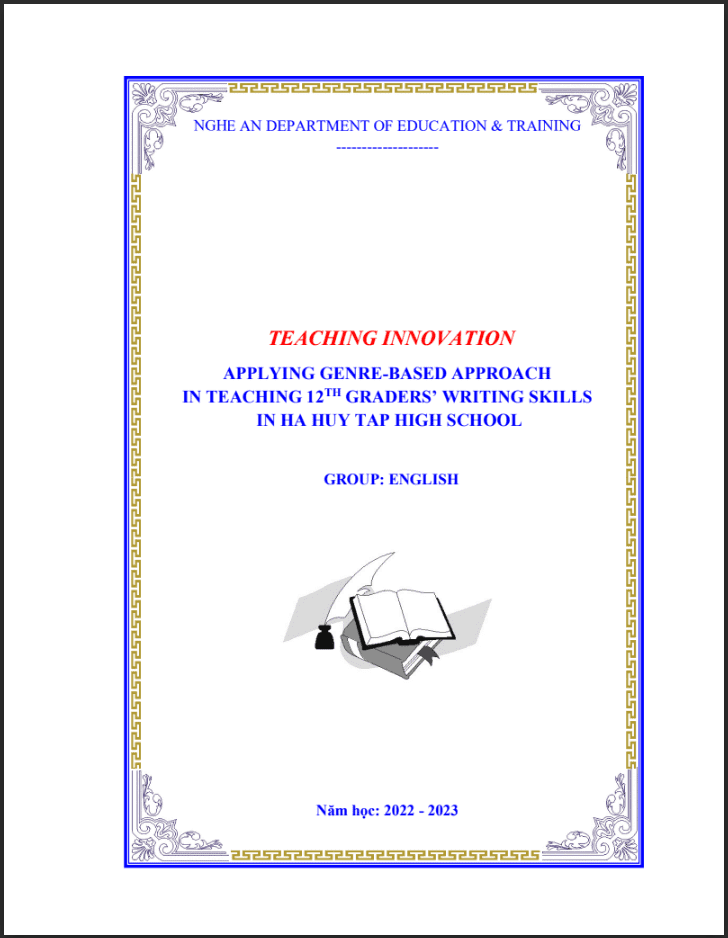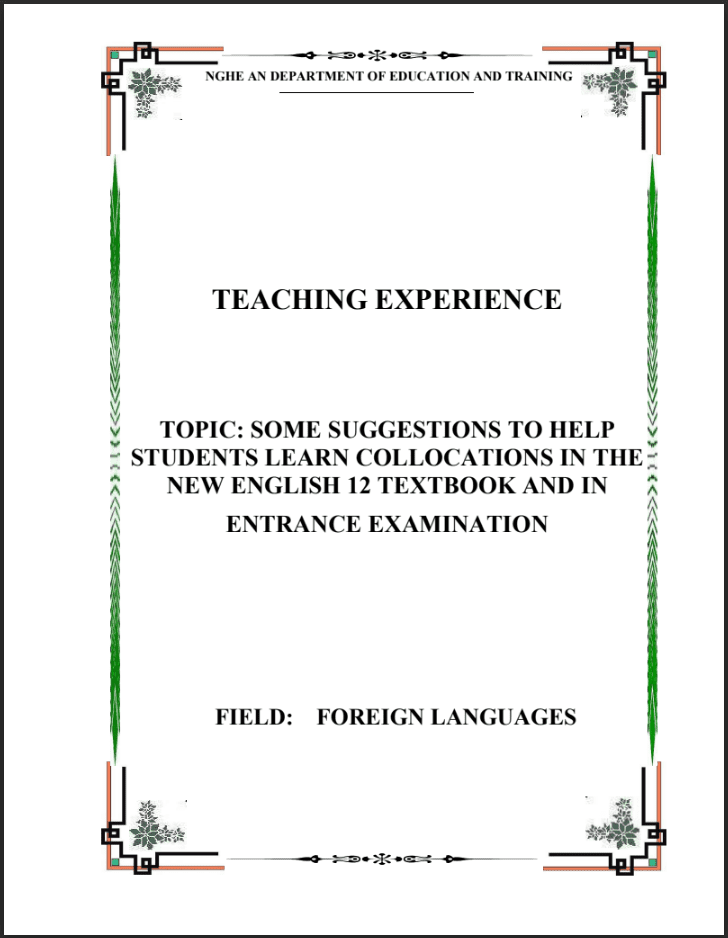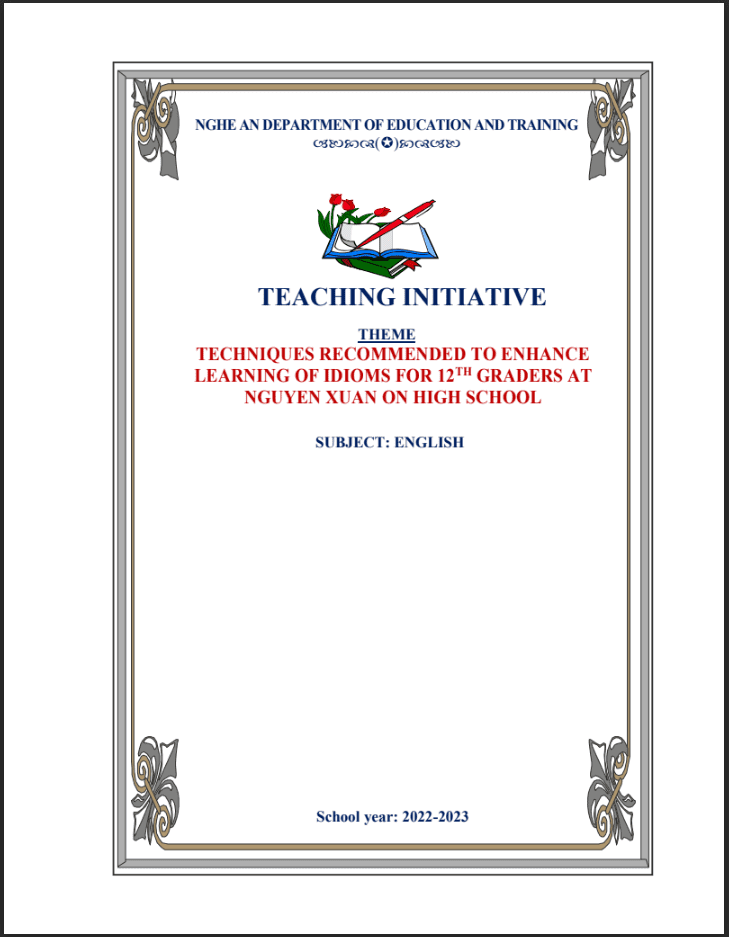SKKN Setting strategies in teaching receptive skills to improve students’ skill in listening activities in the new text book” Tieng Anh 10″ Global Success
- Mã tài liệu: MP0088 Copy
| Môn: | Tiếng Anh |
| Lớp: | 10 |
| Bộ sách: | Global Success |
| Lượt xem: | 497 |
| Lượt tải: | 2 |
| Số trang: | |
| Tác giả: | Nguyễn Thị Lan Hương |
| Trình độ chuyên môn: | Cử nhân đại học |
| Đơn vị công tác: | THPT Quỳ Châu |
| Năm viết: | 2022-2023 |
| Số trang: | |
| Tác giả: | Nguyễn Thị Lan Hương |
| Trình độ chuyên môn: | Cử nhân đại học |
| Đơn vị công tác: | THPT Quỳ Châu |
| Năm viết: | 2022-2023 |
Sáng kiến kinh nghiệm “Setting strategies in teaching receptive skills to improve students’ skill in listening activities in the new text book” Tieng Anh 10″ Global Success”triển khai gồm các biện pháp nổi bật sau:
Mô tả sản phẩm
ucation to meet the demand of the modern society in the
process of integration and development, the Vietnamese Ministry of Education and
Training has introduced the new English textbooks since the school year 2022-
2
023 in the view of Education and Training Programme 2018. With this reform,
beside the excitement of getting the new and advanced knowledge with modern
method of teaching and learning, both teachers and students have certain difficulty
in mastering the skills in the process of teaching and learning English.
Of the skills, listening, in general, is proved a relatively difficult one for
students, especially Vietnamese students to master. Students lack of authentic
sources and, as more important, efford of training their listening skill. They
consider listening as a challenging skill to conquer. When practising listening,
students tend to be confused and lost their way in the stream of strange words,
expressions. Their minds confuse to try to understand more and at last, they quit
the job. Furthermore, due to the limited background knowledge as well as essential
skills, they often feel scary when carrying out listening tasks, especially when
lacking supports and motivation from teachers. Due to students’ lack of practising,
time constraints and low motivation, listening skills still remain impossible field in
upper-secondary schools and teaching listening skills is a hard job for many
teachers.
Most listening activities, in the upper-secondary syllabus in general, and in
the new textbook “Tieng Anh 10” introduced officially in 2022 in particular, are
designed in a controlled listening format. The content of listening comprehension
tasks are quite new and difficult with upper-secondary students. This, to some
extent, demotivates students because they don’t have enough experiences and skills
to understand the track and do the tasks efficiently
Besides, from the experience in teaching speaking skills to the 10th form
students who have a rather low level of proficiency in learning English, the author
realizes that inspite of the students’ lack of skills and knowledge, they are able to
learn listening comprehension more effectively if they are suggested suitable
strategies while listening.
Related to these problems, this study was carried out, entitling: Setting
strategies in teaching receptive skills to improve students’ skill in listening
activities in the new text book” Tieng Anh 10″ Global Success
2
. Aims of the Study
The study aims at suggesting setting strategies applied for some listening task
activities given in the new textbook “Tieng Anh 10” Global Success to
4
improve10th graders’ skill in listening activities
PART II: CONTENT
- THEORETICAL BACKGROUND
1
. Teaching receptive skills.
Teaching receptive skills in English is known as teaching listening and
reading.
1
.1. What does teaching receptive skills involve?
Three important things should be taken into account when teaching receptive
skills:
Teaching receptive skills is aimed to help the learners develop the necessary
skills to understand and interpret spoken or written materials. Consequently,
teachers have to avoid focusing only on testing the learners’ performance in getting
the meaning of the texts. Instead we should also aim at training them to use the
reading and listening strategies that enable them to deal with any type of text.
People read or listen for a purpose, which can be to get specific information
or to get a general idea of a text. Sometimes, listening and reading are done just for
pleasure as when we read poetry or listen to a podcast.
Receptive skills are not passive. Listeners and readers make use of important
cognitive processing while listening or reading. Two of the most important
activities that occur in the mind while processing a text are top-down and bottom-up
2
2
. Listening skills
.1. Definition of listening
Listening is a basic skill that language learners should master with the other
language skills. It is defined as a complex process of receiving language through
the ears. Listening involves identifying the sounds of speech and processing them
into words and sentences. When we listen, we use our ears to receive individual
sounds (letters, stress, rhythm and pauses) and we use our brain to convert these
into messages that mean something to us.
Listening in any language requires focus and attention. It is a skill that some
people need to work at harder than others. People who have difficulty
concentrating are typically poor listeners. Listening in a second language requires
even greater focus.
2
.2. Elements of listening
Author Marvin Gottlieb cites four elements “of good listening:
–
–
Attention – the focused perception of both visual and verbal stimuli
Hearing – the physiological act of ‘opening the gates to your ears’
5
–
–
Understanding – assigning meaning to the messages received
Remembering – the storing of meaningful information” (“Managing Group
Process.” Praeger, 2003)
He also cites
four
levels
of
listening:
“acknowledging,
sympathizing, paraphrasing, and empathizing. The four levels of listening range
from passive to interactive when considered separately. However, the most
effective listeners are able to project all four levels at the same time.” That means
they show they’re paying attention, they show interest, and they convey they are
working to understand the speaker’s message.
3
. Setting strategies for listening comprehension as a key feature of teaching
listening skills
3
.1. What are strategies for listening comprehension?
Strategy is an intended plan to achieve a specific purpose.
As readers or listeners, we never start listening completely from a “zero
starting-point.” Instead, we always use our prior knowledge to predict what the text
will be about or to make sense of what is said or written. In addition, we always
look for contextual clues to help in our quest for making sense of the text. We also
often recall and connect the information in the text to other texts, to ourselves and
the world.
Teachers need to understand that teaching listening comprehension is not
merely testing comprehesion. Rather, a receptive skill lesson aims at training the
learners to make use of different strategies to get meaning from written or spoken
texts. These strategies are related to either top-down or bottom-up cognitive
processing. Ideally, the teacher should start with a general understanding of the
text (i.e. top-down processing) and end up with a more detailed understanding (i.e.
bottom-up processing).
3
.2. Short descriptions of some strategies for listening comprehension
Here are short descriptions of some of these strategies:
Predicting/Previewing: Using information or elements from a passage (e.g. title,
sub – titles, headings, pictures, diagrams, words in bold type, first sentence of each
paragraph…) and personal background knowledge to anticipate what the text is
about
Skimming: Listening to a text to get its general idea (i.e. to get the gist) of the
content.
Scanning: Listening to a text to locate a specific fact or piece of information.
This may be a date, a name or a figure…This strategy is also referred to as
reading/listening for specific details
Questioning: Generating questions about the text and the speaker’s intentions.This
6
helps learners get engaged actively with a text instead of listening to it passively.
Making connections: Readers relate the content of the passage to self, to other
texts or to the world. Good readers take advantage of the connections they make
between the current passage with:
–
–
–
Their personal experiences (text-to-self),
The content from other texts (text-to-text),
Their knowledge about the world (text-to-world).
TÀI LIỆU LIÊN QUAN
- 7
- 105
- 1
- [product_views]
- 5
- 173
- 2
- [product_views]
- 4
- 165
- 3
- [product_views]
- 4
- 129
- 4
- [product_views]
100.000 ₫
- 6
- 434
- 5
- [product_views]
100.000 ₫
- 2
- 507
- 6
- [product_views]
100.000 ₫
- 9
- 546
- 7
- [product_views]
100.000 ₫
- 4
- 409
- 8
- [product_views]
100.000 ₫
- 2
- 595
- 9
- [product_views]
100.000 ₫
- 0
- 538
- 10
- [product_views]

